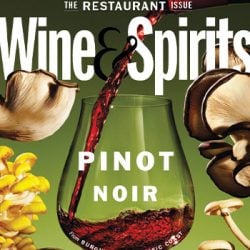

“What gives me the most satisfaction, to be honest, is any bottle of sparkling wine that gets opened on any table, no matter the price point.” For Jackie Pirolo, at Macchialina in Miami Beach, sparkling wines pair well with the menu and with the local climate. “When people understand that and aren’t just thinking it’s something to celebrate with, I get really excited. I’m always intrigued with sparkling wine over-all—it doesn’t have to be, you know, the expensive stuff. I love some of these sparkling wines coming out of Emilia-Romagna—that was kind of my first ‘aha’ moment in the wine world.”
Aside from Pirolo, whose Instagram handle is @Lambrusco574, the vast majority of the sommeliers we interviewed listed Champagne among their personal favorites—with most of them listing it first. For Erin Healy at Restaurant Daniel in New York, Champagne is part of her personal history, touching on her studies abroad, in the Montagne de Reims, during high school. On her Champagne list right now, she’s most excited about the Domaine Le Mont Fournois wines: “It’s a project by the Bérêche family—they partnered up with a cousin, Juliette, a super-energetic, really brilliant young woman. And so while they’re developing this vineyard in Ludes, they created partnerships with growers in the grand cru villages, producing single-vintage pictures of grand cru village wines.
“One of the more special bottles is the 2017 Oger Grand Cru. It’s got so much texture, so much density, so much savory expression with chardonnay that I think sometimes is lacking these days in Champagne. [In the Brut Nature wines], there was a lot of talk about purity of chardonnay, which I think is still super important, but it also makes me miss those brioche bombs a little bit. This wine really achieves that purity of chardonnay, but while also giving you that sense of decadence that I think is so important, especially with vintage Champagne. And I really appreciate those decadent Champagnes, wines that make you feel a little guilty, maybe, when you drink them. It’s a sexy wine; it’s food-friendly. It’s a great way to look at Champagne in a very classic sense—a little bit less of a conversation of single-vineyard terroir, but more of just, ‘What is this greater place?’”
It seemed everyone we spoke with had their own favorite Champagne. Whether it was the “ethereal” Brocard Pierre for Tina Vaughn at Eulalie, J. Lassalle for Cedric Nicaise at The Noortwyck, or Jacques Selosse Côte Faron Lieu-dit for Hannah Williams of Blue Hill at Stone Barns, sommeliers like their bubbles. While several wine directors reported a fall-off in bottle sales, which they attribute to guests either ordering a cocktail before dinner, or cutting back to one bottle of wine with dinner, many more reported robust Champagne sales. “Everybody who comes into the steakhouse is celebrating something, so we do go through a good amount of Champagne,” says Chris Belk at Bern’s in Tampa, where grower Champagne and Special Club bottles are gaining ground. In Houston and Dallas, Steven McDonald, MS, has nine pages of Champagne on his Pappas Steakhouse lists. “If this was any other company, I don’t think they would’ve let us do that.” McDonald says they take very soft margins on certain wines—not the mainstream brands. “We just have to work a little harder than if we were doing cuisine that was more suited to Champagne. But we serve massive seafood towers and it makes perfect sense.”


“We are selling more Champagne than ever, but we’re selling a $30 glass of Champagne, and I was just in New York a few weeks ago and it was like , minimum $45. At that price, I wouldn’t be surprised if people were skipping Champagne for even just a softer $20 to $25 cocktail that seems more reasonable.” —Steven McDonald, Pappas Steakhouse, Houston & Dallas
This year, Champagne accounted for 20 percent of Kester Masias’s wine sales at Harlo in Las Vegas. “Las Vegas in general, it is one of the largest Champagne consumers domestically because of the nightclub scene on the Strip,” Masias says. “Off the Strip, we don’t have a nightlife component. So, our Champagne sales are really more geared towards the gastronomic pleasures of pairing.”
In Los Angeles, that pairing might be with Southern Thai fried chicken at Anajak Thai. “It’s one of my favorite things about this restaurant,” says Ian Krupp. “Despite all the accolades, people just want to come and eat fried chicken. I love the high/low thing. Fried chicken night happens at one long table laid out in the alley next to the restaurant. So, you know, you’re eating fried chicken in an alley, but you’re drinking grower Champagne.
“Fried chicken and Champagne is a classic pairing—everybody knows that. But to be able to curate something that’s a little more focused, with single-vineyard sites or old-vine sites or biodynamic producers, that’s one of my favorite things.”
The next essay in our sommelier interview series, Just Chill, details the rise in sales of chillable reds.
Joshua Greene is the editor and publisher of Wine & Spirits magazine.
This story appears in the print issue of Spring 2024.
Like what you read? Subscribe today.

















